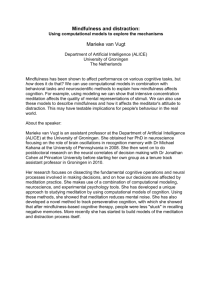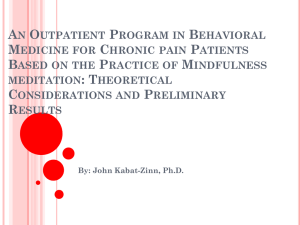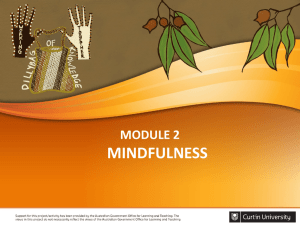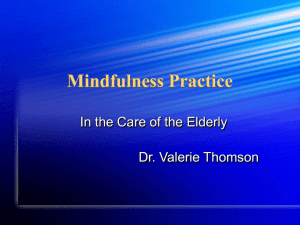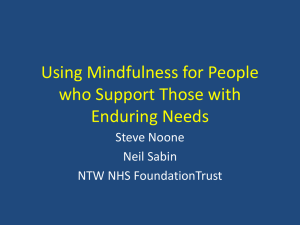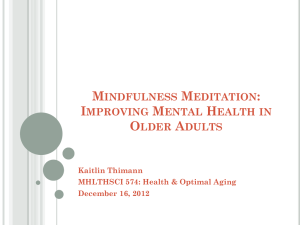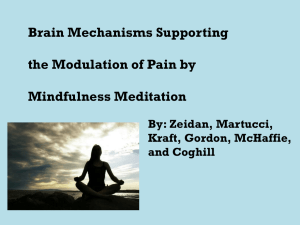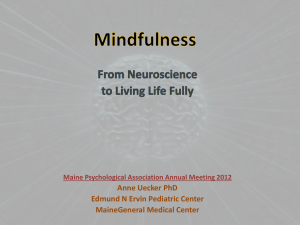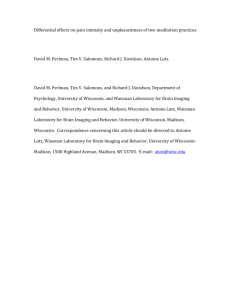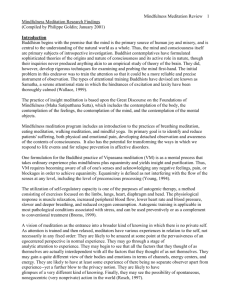PPT - MinneTESOL
advertisement
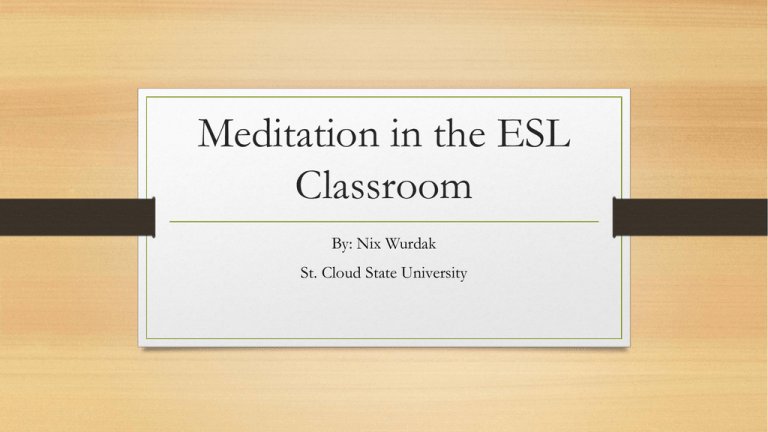
Meditation in the ESL Classroom By: Nix Wurdak St. Cloud State University Who am I? • • • • Teacher Master’s Student 200 Hour RYS Instructor Meditative struggler since 2007 Me. Practice What You Preach Jargon • Meditation: anything a person does to calm and center • Mindfulness: “the ability to pay attention to what you’re experiencing from moment to moment—without drifting into thoughts of the past or concerns about the future, or getting caught up in opinions about what is going on” (President and Fellows at Harvard College, 2004, p. 1 ). • MBSR: 8-10 week meditative program devised by Jon Kabat-Zinn • TM (Transcendental Meditation): A frequently used method of meditation What does meditation do? • • • • • • • • Decreases anxiety (and cortisol) Decreases suicidal ideation Improves information retention Improves concentration Higher GPAs Higher scores on GRE Pain reduction Improves skin conditions • Improves executive functioning • Increases ability to deal with physical • • • • • pain Decreases need for sleep Boosts immune system Lowers blood pressure Moderates effects of PTSD Increased vaccine efficacy My favorite bit… Images by Andrew Newberg, Thomas Jefferson University, Information by Richard Davidson, University of Wisconsin - Madison My Research • Studied impact of single session meditation on writing in IEP. • Looked at passage length, diversity of vocabulary, and cohesive markers. • Findings: • One session doesn’t cut it, statistically. • Students want it! “With meditation you are not wandering every time about the thing that you have in your mind. It makes you focus on the thing ongoing.” 24 year old, Burkina Faso A Few Methods of Meditating • Breathing • Yoga • Guided Meditation • Walking meditation • Mantras • Tactile aids • T’ai Chi • Qi’Gong Ways to Bring Meditation Into Your Classroom • • • • • • Start slowly and start small. Know your student base. Elementary: yoga, guided imagery High School: breathing, mantras, music Adult: breathing, walking meditation Pull Out: use headphones Great Sources for More Information - http://www.marc.ucla.edu - Online Guided Meditations - Resources - http://www.kidsrelaxation.com - Guided meditations for young children - Common Ground Meditation Center (http://commongroundmeditation.org/) - Online Guided Meditations - Events and classes - Full Catastrophe Living by Jon Kabat-Zinn - Anything by Richard Davidson (University of Wisconsin – Madison) Questions? Feel free to contact me: nwurdak@gmail.com References • Albrecht, Nicole J.; Albrecht, Patricia M.; and Cohen, Marc (2012) "Mindfully Teaching in the Classroom: a Literature Review," Australian Journal of Teacher Education, 37(12), Article 1. • Matsuda, S., & Gobel, P. (2004). Anxiety and predictors of performance in the foreign language classroom. System, 32(1), 21-36. • Baitinger, K. (2005). Engaging adult learners in the writing/ESL classroom.College Quarterly, 8(1), 1-10. • Mayes, S. D., & Calhoun, S. (2007). Learning, attention, writing, and processing speed in typical children and children with ADHD, autism, anxiety, depression, and oppositional-defiant disorder. Child Neuropsychology, 13(6), 469-493. • Barwick, N. (1995). Pandora’s box: An investigation of essay anxiety in adolescents.Psychodynamic Counseling. 1(4), 560-575. • McKamey, C. (2011). Uncovering and managing unconscious ways of 'looking': A case study of researching educational care. Psychodynamic Practice, 17(4), 403-417. • Belanoff, P. (2001). Silence: reflection, literacy, learning, and teaching. College Compositionand Communication, 52(3), 399-428. • Moore, M. (1992). Using meditation in the classroom. Hispania, 75(3), 734-735. • Davidson, R. J., Kabat-Zinn, J., Schumacher, J., Rosenkranz, M., Muller, D., Santorelli, S., et al. (2003). Alterations in brain and immune function produced by mindfulness meditation. Psychosomatic Medicine, 65(4), 564-570. • Mrazek, M., Franklin, M., Baird, B., Schooler, J., & Phillips, D. T. (2013). Mindfulness training improves working memory capacity and GRE performance while reducing mind wandering. • Fredrickson, B. (2009). Positivity. New York: Crown Publishers. • Napoli, D. M., Krech, P. R., & Holley, L. C. (2005). Mindfulness training for elementary school students. Journal of Applied School Psychology, 21(1), 99-125. • Garretson, K. (2010). Being allowing and yet directive: mindfulness meditation in the teaching of developmental reading and writing. New Directions For Community Colleges, 2010(151), 51-64. • Nelson, M. (2006). The fruit of silence. Teachers College Record, 108(9), 1733-1741. • Reid, E., & Miller, L. (2009). An exploration in mindfulness: classroom of detectives. Teachers College Record,111(12), 2775–2785. • Riffe, D. & Stacks, D.W. (1992). Student characteristics and writing apprehension. TheJournalism Educator, 47(2), 39-49. • Goldin, P., Ramel, W., & Gross, J. (2009). Mindfulness meditation training and self referential processing in social anxiety disorder: Behavioral and neural effects. Journal of Cognitive Psychotherapy, 23(3), 242-257. • Grossman, P., Niemann, L., Schmidt, S., & Walach, H. (2004). Mindfulness-based stress reduction and health benefits: A meta-analysis. Journal of Psychosomatic • Research, 57(1), 35-43. • Hall, P. D. (1999). The effect of meditation on the academic performance of African American college students.Journal of Black Studies, 29(3), 408-415. • Shapiro, S. L., Carlson, L. E., Astin, J. A., & Freedman, B. (2006). Mechanisms of mindfulness. Journal of Clinical Psychology, 62(3), 373-386. • Heeren, A., & Philippot, P. (2011). Changes in ruminative thinking mediate the clinical benefits of mindfulness: preliminary findings. Mindfulness, 2(1), 8-13. • • Soons, I., Brouwers, A., & Tomic, W. (2010). An experimental study of the psychological impact of a Mindfulness-Based Stress Reduction Program on highly sensitive persons.Europe's Journal of Psychology, 148-169. Horwitz, E. (2001). Language anxiety and achievement. Annual Review of Applied Linguistics, 21, 112-126. • • The benefits of mindfulness. (Cover story). (2004). Harvard Women's Health Watch, 11(6) 1-3. Johnson, D., & Johnson, L. (2010). Reinventing the stress concept. Ethical Human Psychology and Psychiatry, 12(3), 218-231. • • Kabat-Zinn, J. (2009). Full catastrophe living: using the wisdom of your body and mind to face stress, pain, and illness. New York: Delta Trade Paperbacks. (Original work published 1990) Van Dam, N. T., Earleywine, M., & Danoff-Burg, S. (2009). Differential item function across meditators and non-meditators on the five facet mindfulness questionnaire. Personality and Individual Differences, 47(5), 516-521. • Keogh, E., Bond, F. W., & Flaxman, P. E. (2006). Improving academic performance and mental health through a stress management intervention: outcomes and mediators of change. Behaviour Research and Therapy, 44(3), 339-357. Semple, R. J., Reid, E. F., & Miller, L. (2005). Treating anxiety with mindfulness: an open trial of mindfulness training for anxious children. Journal of Cognitive Psychotherapy, 19(4), 379-392.

